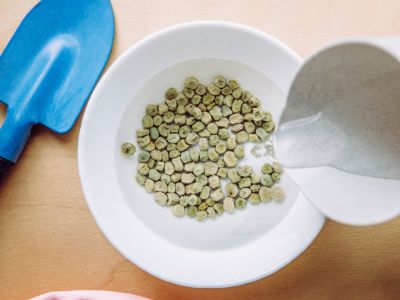Reasons for Soaking Seeds
What happens to seeds when you soak them? Why should you soak your seeds? The short answer is because your seeds were designed to be abused. Mother Nature is not kind to a little seed. In the wild, a seed can expect to encounter harsh heat and cold, very wet or dry conditions and may even need to survive the acid-filled digestive tract of an animal. In short, seeds have developed over millions of years with defenses to survive awful conditions. But in your modern day garden, a seed is relatively pampered. Soaking seeds before planting helps you to break down the seed’s natural defenses against what it expects from Mother Nature, which then allows it to germinate faster. Another reason is that while Mother Nature actively assaults seeds, she also gave those seeds an internal gauge to help them know when they should grow. For most seeds, moisture levels play a big role in alerting a seed to optimal grow times. By soaking the seeds, you can quickly boost the moisture content around the seeds, which signals to the seed that it is now safe to grow. And lastly, for some types of seeds, they actually contain germination inhibitors that are designed to prevent a seed from germinating inside the fruit. These inhibitors must be leached away before a seed can germinate. In nature with natural rainfall, this process can take some time. But when you soak your seeds, the process is sped up.
How to Soak Seed Before Planting
Seed soaking, at a basic level needs two things: seeds and water. Some methods for seed soaking may substitute the water for slightly acidic solutions, such as weak tea or coffee or even acidic chemicals. These acidic solutions are meant to imitate loosely the stomach acid of an animal. But these solutions are not necessary in most cases. For most seeds, water will work just fine. Take a small bowl and fill it with water from your tap, as hot as your tap will allow. Some seeds can tolerate boiling water, but as the tolerance for heat can vary greatly from species to species, hot tap water is safest for seed soaking. Once your bowl is filled with hot water, place your seeds inside the bowl, then allow the seeds to stay in the water as it cools down. Common questions at this point include “How long should seeds be soaked?” and “Can you over soak seeds?” Yes, you can over soak seeds. Too much soaking in water and a seed will drown. It is recommended that you only soak most seeds for 12 to 24 hours and no more than 48 hours. The seeds of some species of plants can survive longer soakings, but you should only do this if the specific instructions for this species recommend so. There are things you can do to improve how well your seeds react to soaking. Large seeds or seeds with particularly hard coats can benefit from scarification before soaking. Scarification means to damage the seed coat in some way so that the water is better able to penetrate the seed. Scarification can be done through several methods. These include rubbing the seed on fine grain sand paper, nicking the seed coat with a knife, and even gently tapping the seed with a hammer to help crack the seed coat. After soaking your seeds, they can be planted as directed. The benefit of soaking seeds before planting is that your germination time will be reduced, which means you can have happy, growing plants faster.
